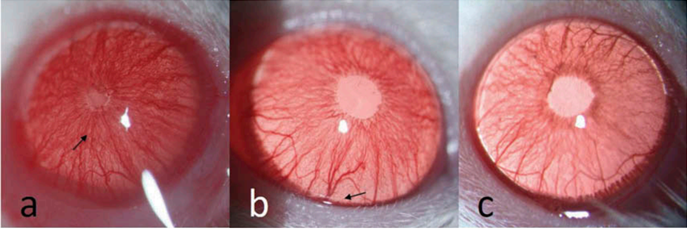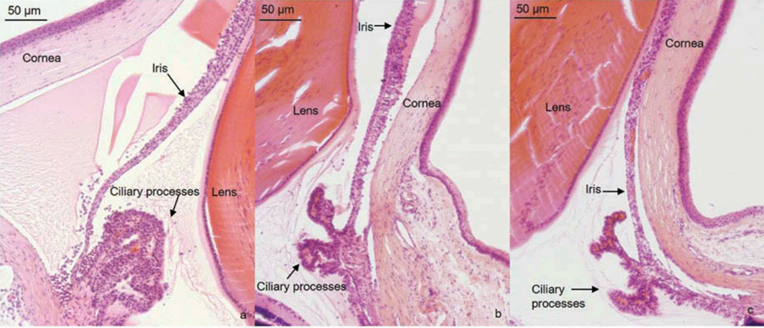Endotoxin Induced Uveitis (EIU)
Endotoxin induced uveitis (EIU) is an established animal model that resembles acute anterior uveitis in human. It is induced by systemic injection of LPS, a component located on the outer membranes of gram-negative bacteria. The pathological characteristics of endotoxin- induced uveitis include ocular infiltration of inflammatory cells and leakage of protein into the anterior chamber of the eye. Creative Bioarray focuses on drug research and development services and helps customers explore basic mechanism of uveitis and investigate new potential treatment targeting uveitis by EIU model.
Application
- Acute anterior uveitis
Our capabilities
- We evaluate the severity of uveitis using clinical score system.
- We assess the eye lesions by fundoscopy.
- We isolate and identify T cell subsets from eye or other organs via FACS.
Assays available
- Histopathological evaluation
- Protein concentration in the aqueous humor
- Mediator concentration (prostaglandin, leukotriene, etc.)
- Fundoscopy
- FACS analysis
With extensive experience in the field of uveitis, we are confident to help you to overcome any upcoming challenges. Our experts are fully capable of customizing our protocols and assays to meet your specific needs. With our help, we wish to facilitate your research with high efficiency.
Study examples
 Figure. 1. (a) Occlusion of pupil and fibrinous membrane (arrow) was observed in the EIU group at 24 h after LPS injection. (b) Only blood vessel dilatation in the iris (arrow) could be found in the ET group at 24 h after LPS injection. (c) No ocular inflammatory signs were observed in the normal control group.
Figure. 1. (a) Occlusion of pupil and fibrinous membrane (arrow) was observed in the EIU group at 24 h after LPS injection. (b) Only blood vessel dilatation in the iris (arrow) could be found in the ET group at 24 h after LPS injection. (c) No ocular inflammatory signs were observed in the normal control group.
 Figure. 2. (a) In the EIU group, the iris stroma was thickened, and vasodilatation was observed. Fibrin exudations and a large number of inflammatory cell infiltrations of massive neutrophil and small amounts of mononuclear cells and lymphocyte could be observed in the anterior chamber and the vitreous humor of the rats 24 h after LPS immunization. (b) The inflammation levels of the rats in the ET group were significantly decreased compared with those in the EIU group and only a small amount of inflammatory cell infiltration and were found in the iris–ciliary body complex. (c) No inflammatory signs were observed in the normal control group.
Figure. 2. (a) In the EIU group, the iris stroma was thickened, and vasodilatation was observed. Fibrin exudations and a large number of inflammatory cell infiltrations of massive neutrophil and small amounts of mononuclear cells and lymphocyte could be observed in the anterior chamber and the vitreous humor of the rats 24 h after LPS immunization. (b) The inflammation levels of the rats in the ET group were significantly decreased compared with those in the EIU group and only a small amount of inflammatory cell infiltration and were found in the iris–ciliary body complex. (c) No inflammatory signs were observed in the normal control group.
Quotation and ordering
If you have any special needs or questions regarding our services, please feel free to contact us. We look forward to cooperating with you in the future.
Reference
Yu S, et al. Protection of Lipopolysaccharide (LPS) Preconditioning against Endotoxin-Induced Uveitis (EIU) in Rats Is Associated with Overexpression of Interleukin-1 Receptor-Associated Kinase M(IRAK-M)[J]. Ocular Immunology and Inflammation, 2017:1-8.
For research use only. Not for any other purpose.
Disease Models
- Oncology Models
-
Inflammation & Autoimmune Disease Models
- Rheumatoid Arthritis Models
- Glomerulonephritis Models
- Multiple Sclerosis (MS) Models
- Ocular Inflammation Models
- Sjögren's Syndrome Model
- LPS-induced Acute Lung Injury Model
- Peritonitis Models
- Passive Cutaneous Anaphylaxis Model
- Delayed-Type Hypersensitivity (DTH) Models
- Inflammatory Bowel Disease Models
- Systemic Lupus Erythematosus Animal Models
- Oral Mucositis Model
- Asthma Model
- Sepsis Model
- Psoriasis Model
- Atopic Dermatitis (AD) Model
- Scleroderma Model
- Gouty Arthritis Model
- Carrageenan-Induced Air Pouch Synovitis Model
- Carrageenan-Induced Paw Edema Model
- Experimental Autoimmune Myasthenia Gravis (EAMG) Model
- Graft-versus-host Disease (GvHD) Models
-
Cardiovascular Disease Models
- Surgical Models
- Animal Models of Hypertension
- Venous Thrombosis Model
- Atherosclerosis model
- Cardiac Arrhythmia Model
- Hyperlipoidemia Model
- Doxorubicin-induced Heart Failure Model
- Isoproterenol-induced Heart Failure Model
- Arterial Thrombosis Model
- Pulmonary Arterial Hypertension (PAH) Models
- Heart Failure with Preserved Ejection Fraction (HFpEF) Model
-
Neurological Disease Models
- Alzheimer's Disease Modeling and Assays
- Seizure Models
- Parkinson's Disease Models
- Ischemic Stroke Models
- Acute Spinal Cord Injury (ASCI) Model
- Traumatic Brain Injury (TBI) Model
- Hypoxic-Ischemic Encephalopathy (HIE) Model
- Tourette Syndrome (TS) Model
- Amyotrophic Lateral Sclerosis (ALS) Model
- Huntington's Disease (HD) Model
- Intracerebral hemorrhage (ICH) Models
- Schizophrenia Model
- Pain Models
-
Metabolic Disease Models
- Type 1 Diabetes Mellitus Model
- Type 2 Diabetes Mellitus Model
- Animal Model of Hyperuricemia
-
Nonalcoholic Fatty Liver Disease Model
- High-Fat Diet-Induced Nonalcoholic Fatty Liver Disease (NAFLD) Model
- Methionine and Choline Deficient (MCD) Diet-Induced Nonalcoholic Fatty Liver Disease (NAFLD) Model
- Gubra-Amylin NASH (GAN) Diet-Induced Nonalcoholic Fatty Liver Disease (NAFLD) Model
- Streptozotocin (STZ) Induced Nonalcoholic Fatty Liver Disease (NAFLD) Model
- High Fat Diet-Induced Obesity Model
- Diabetic Foot Ulcer (DFU) Model
- Liver Disease Models
- Rare Disease Models
- Respiratory Disease Models
- Digestive Disease Models
-
Urology Disease Models
- Cisplatin-induced Nephrotoxicity Model
- Unilateral Ureteral Obstruction Model
- 5/6 Nephrectomy Model
- Renal Ischemia-Reperfusion Injury (RIRI) Model
- Diabetic Nephropathy (DN) Models
- Passive Heymann Nephritis (PHN) Model
- Adenine-Induced Chronic Kidney Disease (CKD) Model
- Kidney Stone Model
- Doxorubicin-Induced Nephropathy Model
- Orthotopic Kidney Transplantation Model
- Orthopedic Disease Models
- Ocular Disease Models
- Skin Disease Models
- Infectious Disease Models
- Otology Disease Models